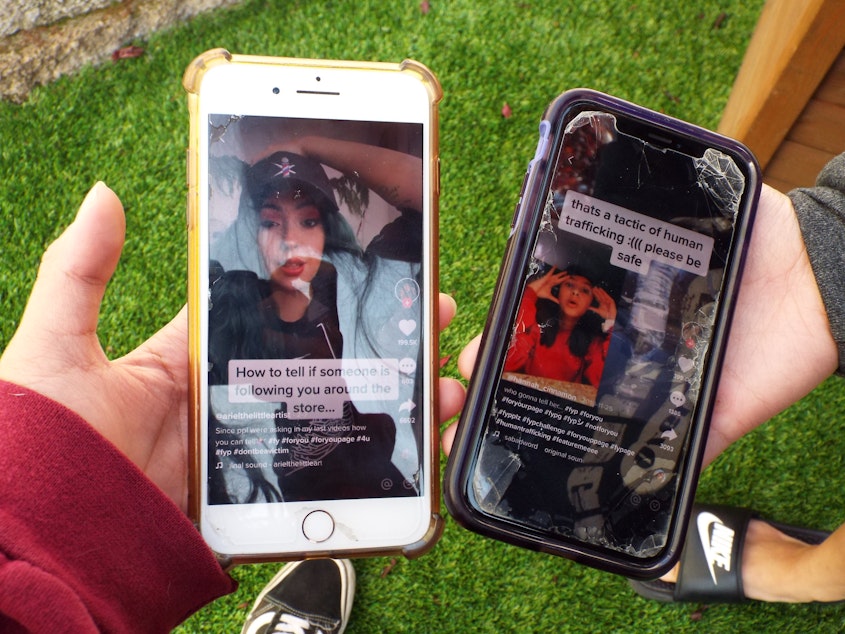Teens are warning each other about sex trafficking on TikTok. Here’s why the videos could do more harm than good

On a single day in King County, an estimated 300 to 500 children under the age of 18 are sex trafficked, according to the Seattle organization Real Escape from the Sex Trade (REST).
The dangers of getting forced into sex trafficking are something that everyday teenagers are warning each other about online. But the information shared in videos is often misleading — and it may keep us from recognizing the real risks.
As I scroll through TikTok, I see some trending dances and memes. And then I stumble across this: a homemade video from a teen in Seattle about sex trafficking north of Seattle.
My friends — and a lot of other teenagers — are sharing posts like this to warn other teens about how to avoid becoming a victim of sex trafficking.
The photos and videos are spreading like wildfire online, with tens of thousands of retweets, likes and shares.
One of the most common posts is about zip ties on cars. It has photos of zip ties attached to side view mirrors and windshield wipers. The caption reads, “If you see this on your vehicle, leave immediately. Traffickers are doing this to distract and kidnap you.”
But this is not an accurate portrayal of sex trafficking, says Audrey Baedke, a programs manager at the Seattle organization Real Escape from the Sex Trade (REST). She told me the reality is very different than what’s being posted online.
Sponsored
“When we look at individuals who have experienced trafficking,” Baedke says, “the majority of times, they are recruited by somebody who builds trust with them. It rarely is a stranger on the street that comes and grabs an individual and puts them into the sex trafficking ring.”
While things like that do happen, Baedke says most of the time, it starts with the victim meeting a man, and “him becoming my boyfriend, somebody that I trust, somebody that I love, somebody that I want to be with and please.”
This is exactly what happened to someone else I talked to. She’s a sex trafficking survivor, now in her early 40s. We’re not using her name to protect her privacy.
At a young age, she was sexually abused by a family member, then taken from her parents and put into foster care.
“Shortly after, I ended up meeting a pimp out there on Third Avenue and Pike, and that’s how it all started,” she says.
Sponsored
At the time, she felt abandoned, like her parents didn’t want her. She got into the pimp’s car, and he took her to lunch and shopping.
“He got to know me,” she says, “and my backstory, my life, and created a story, a fairy tale story of, ‘Oh, it’s gonna be me and you against the world, and we’re gonna make so much money,’ and basically sold me on a dream of love and belonging.”
But instead, within two weeks, she was on Pacific Highway and Aurora Avenue being forced to have sex for money., Many people refer to this as sex trafficking, but the survivor calls it rape.
She says she was lied to and used for the next seven years, and it ended when the FBI arrested her.
She got out of the life, as it’s known, and now has her own job. The survivor is now working with a therapist.
Sponsored
I was surprised by her story. She wasn't captured and thrown in a van, like the videos warn us about. Instead, she was betrayed by someone who earned her trust over time.
Baedke says those online posts I saw could do real damage to teens because they’re not true.
“For example,” Baedke says, “if you are concerned about predators following you in a store, you don’t worry about the people that you let into your life on social media.”
She says if you’re watching for victims with duct tape on their mouths, you won’t notice the silent pleas of help from friends, classmates or loved ones.
I also learned that foster care kids and people of color are at greater risk for being sex trafficked. Both are true for the survivor I spoke to.
Sponsored
The reality of sex trafficking is so different from the social media warning posts that teens share.
The world of pimps, buyers and victims is a lot quieter — and hidden in plain sight.
This story was created in KUOW's RadioActive Advanced Producers Workshop for teenagers, with production support from Kyle Norris. Edited by Anna Boiko-Weyrauch.
Find RadioActive on Facebook, Twitter, TikTok and Instagram, and on the RadioActive podcast.
Support for KUOW's RadioActive comes from the Bill & Melinda Gates Foundation Discovery Center.



